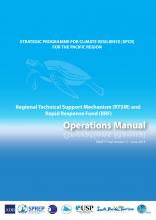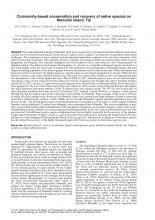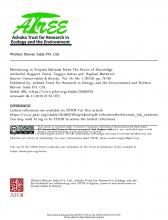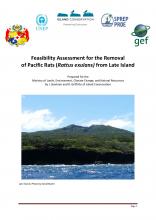Community-based conservation and recovery of native species on Monuriki Island, Fiji


Island and Ocean Ecosystems, BRB
Available Online
Brown, J.
,
Chand, R.
,
Cranwell, S.
,
Fisher, R.N.
,
Harlow, P.
,
Lovich, K.
,
Niukula, J.
,
Rasalato, S.
,
Seniloli, E.
,
Thaman, B.
,
Thomas-Moko, N.
,
Vadada, J.
2019
The small uninhabited island of Monuriki (40.4 ha) in western Fiji is of national and international conservation concern for its several protected species. Exotic invasive species and a Category 5 cyclone have exacerbated conservation challenges. The cooperation of local, national, and international stakeholders continues to be crucial in restoration of the islands native ?ora and fauna. This summary presents a timeline of restoration efforts and current status of the recovery programme for Monuriki. The critically endangered dry forest habitat of Fiji is only found in a few isolated patches on disparate islands. The Fijian crested iguana (Brachylophus cf. vitiensis) is a critically endangered species restricted to a few small islands in this dry forest zone of western Fiji. The population of crested iguanas on Monuriki Island is the third largest remaining population. Even before iguanas were ?rst documented on the island in the early 1980s, individuals had been removed by local resorts for display purposes, a practice that was previously unregulated. In the late 1990s, the ?rst efforts to conserve and restore Monuriki Island were discussed, but conservation initiatives were not implemented until the development of the Crested Iguana Recovery Plan in 2008. In 2011, domestic goats (Capra hircus) and non-native rats (Rattus exulans) were removed from the island, and 10 pairs of iguanas were brought into captive breeding facilities within Fiji. In 2015, the ?rst 32 captive-bred crested iguanas were released back on Monuriki Island. More than half of these iguanas (N=26) were radio-tracked for 56 days post-release in order to assess survivorship and help provide insights into their short-term movement patterns. Of the 26 iguanas that were tracked, nearly 70% (N=18) were found after 56 days indicating excellent short-term survival. In February 2016, Tropical Cyclone Winston, a Category 5 storm passed through Fiji and devastated some of the tropical dry forest habitat on Monuriki. With sustained winds of up to 230 km/ hr nearly all of the canopy leaves from trees on Monuriki Island were removed and large amounts of debris covered the forest ?oor. Following the cyclone, a brief wildlife survey revealed Monurikis iguana and bird populations were still present. In 2017, the crested iguana captive breeding programme was brought to an end when 16 of the original 20 iguana founders, and an additional 32 captive bred o? spring, were reintroduced onto Monuriki. This was accomplished, in part, due to successful breeding and reestablishment of the remaining wild iguanas on the island. Despite a major storm event, reestablishment likely resulted from reduced egg and hatchling predation by the rats, and excellent habitat recovery after goat removal. Overall these invasive species eradications have proven highly successful for the recovery of the iguanas, wedge-tailed shearwaters (Puffinus paci?cus), and several other non-target species including the banded rail (Gallirallus philippensis) and endangered Fijian peregrine falcon (Falco peregrinus). Furthermore, eradication of non-native species has also helped the recovery of the highly threatened tropical dry forest ecosystem in which these species exist.






